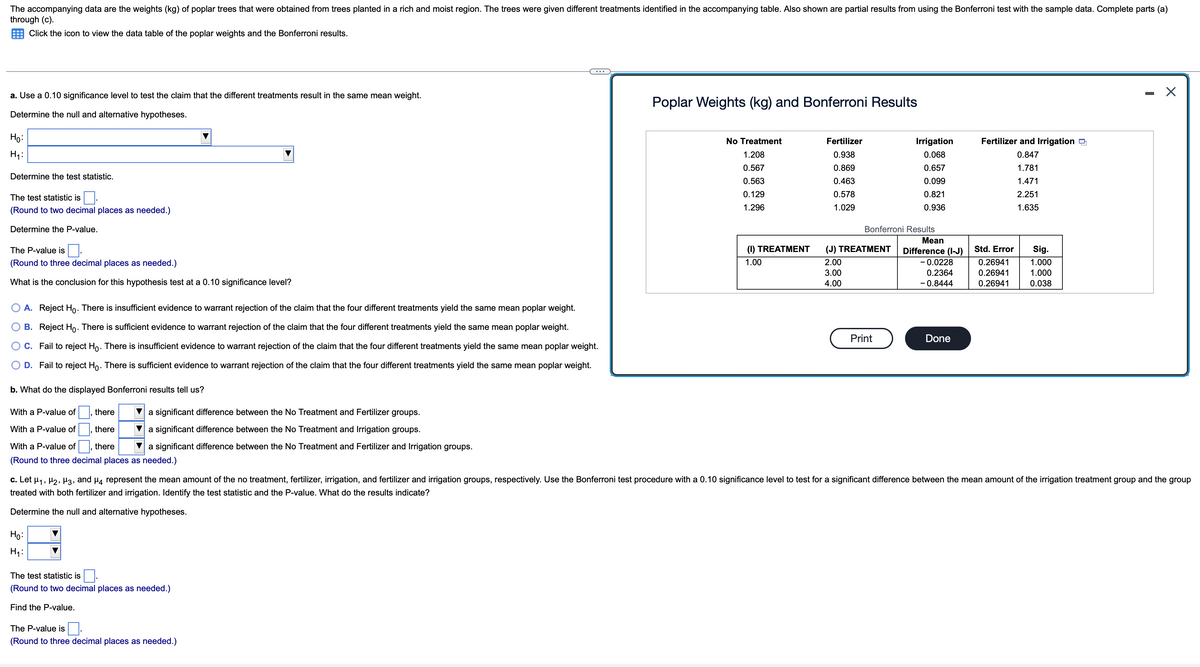The accompanying data are the weights (kg) of poplar trees that were obtained from trees planted in a rich and moist region. The trees were given different treatments identified in the accompanying table. Also shown are partial results from using the Bonferroni test with the sample data. Complete parts through (c). Click the icon to view the data table of the poplar weights and the Bonferroni results. a. Use a 0.10 significance level to test the claim that the different treatments result in the same mean weight. Determine the null and alternative hypotheses. Ho: H₂: Determine the test statistic. The test statistic is (Round to two decimal places as needed.) Determine the P-value. The P-value is ▼ Poplar Weights (kg) and Bonferroni Results No Treatment. 1.208 0.567 0.563 0.129 1.296 Fertilizer 0.938 0.869 0.463 0.578 1.029 Irrigation 0.068 0.657 0.099 0.821 0.936 Bonferroni Results Fertilizer and Irrigation 0.847 1.781 1.471 2.251 1.635 Mean (1) TREATMENT (J) TREATMENT Difference () Std. Error Sig.
The accompanying data are the weights (kg) of poplar trees that were obtained from trees planted in a rich and moist region. The trees were given different treatments identified in the accompanying table. Also shown are partial results from using the Bonferroni test with the sample data. Complete parts through (c). Click the icon to view the data table of the poplar weights and the Bonferroni results. a. Use a 0.10 significance level to test the claim that the different treatments result in the same mean weight. Determine the null and alternative hypotheses. Ho: H₂: Determine the test statistic. The test statistic is (Round to two decimal places as needed.) Determine the P-value. The P-value is ▼ Poplar Weights (kg) and Bonferroni Results No Treatment. 1.208 0.567 0.563 0.129 1.296 Fertilizer 0.938 0.869 0.463 0.578 1.029 Irrigation 0.068 0.657 0.099 0.821 0.936 Bonferroni Results Fertilizer and Irrigation 0.847 1.781 1.471 2.251 1.635 Mean (1) TREATMENT (J) TREATMENT Difference () Std. Error Sig.
College Algebra (MindTap Course List)
12th Edition
ISBN:9781305652231
Author:R. David Gustafson, Jeff Hughes
Publisher:R. David Gustafson, Jeff Hughes
Chapter8: Sequences, Series, And Probability
Section8.7: Probability
Problem 7E: List the sample space of each experiment. Selecting a letter of the alphabet
Related questions
Question

Transcribed Image Text:The accompanying data are the weights (kg) of poplar trees that were obtained from trees planted in a rich and moist region. The trees were given different treatments identified in the accompanying table. Also shown are partial results from using the Bonferroni test with the sample data. Complete parts (a)
through (c).
Click the icon to view the data table of the poplar weights and the Bonferroni results.
a. Use a 0.10 significance level to test the claim that the different treatments result in the same mean weight.
Determine the null and alternative hypotheses.
Ho:
H₁:
Determine the test statistic.
The test statistic is
(Round to two decimal places as needed.)
Determine the P-value.
The P-value is
(Round to three decimal places as needed.)
What is the conclusion for this hypothesis test at a 0.10 significance level?
A. Reject Ho. There is insufficient evidence to warrant rejection of the claim that the four different treatments yield the same mean poplar weight.
B. Reject Ho. There is sufficient evidence to warrant rejection of the claim that the four different treatments yield the same mean poplar weight.
C. Fail to reject Ho. There is insufficient evidence to warrant rejection of the claim that the four different treatments yield the same mean poplar weight.
D. Fail to reject Ho. There is sufficient evidence to warrant rejection of the claim that the four different treatments yield the same mean poplar weight.
b. What do the displayed Bonferroni results tell us?
With a P-value of
there
With a P-value of
there
With a P-value of
there
(Round to three decimal places as needed.)
a significant difference between the No Treatment and Fertilizer groups.
▼a significant difference between the No Treatment and Irrigation groups.
a significant difference between the No Treatment and Fertilizer and Irrigation groups.
Ho:
H₁:
The test statistic is
(Round to two decimal places as needed.)
Find the P-value.
Poplar Weights (kg) and Bonferroni Results
The P-value is
(Round to three decimal places as needed.)
No Treatment
1.208
0.567
0.563
0.129
1.296
(1) TREATMENT
1.00
Fertilizer
0.938
0.869
0.463
0.578
1.029
Irrigation
0.068
0.657
0.099
0.821
0.936
Bonferroni Results
Mean
(J) TREATMENT Difference (I-J)
2.00
3.00
4.00
Print
-0.0228
0.2364
- 0.8444
Done
Fertilizer and Irrigation
0.847
1.781
1.471
2.251
1.635
Std. Error
0.26941
0.26941
0.26941
c. Let μ₁, ₂, 3, and μ4 represent the mean amount of the no treatment, fertilizer, irrigation, and fertilizer and irrigation groups, respectively. Use the Bonferroni test procedure with a 0.10 significance level to test for a significant difference between the mean amount of the irrigation treatment group and the group
treated with both fertilizer and irrigation. Identify the test statistic and the P-value. What do the results indicate?
Determine the null and alternative hypotheses.
Sig.
1.000
1.000
0.038
X
Expert Solution
This question has been solved!
Explore an expertly crafted, step-by-step solution for a thorough understanding of key concepts.
Step by step
Solved in 3 steps with 1 images

Recommended textbooks for you

College Algebra (MindTap Course List)
Algebra
ISBN:
9781305652231
Author:
R. David Gustafson, Jeff Hughes
Publisher:
Cengage Learning

Glencoe Algebra 1, Student Edition, 9780079039897…
Algebra
ISBN:
9780079039897
Author:
Carter
Publisher:
McGraw Hill

College Algebra (MindTap Course List)
Algebra
ISBN:
9781305652231
Author:
R. David Gustafson, Jeff Hughes
Publisher:
Cengage Learning

Glencoe Algebra 1, Student Edition, 9780079039897…
Algebra
ISBN:
9780079039897
Author:
Carter
Publisher:
McGraw Hill